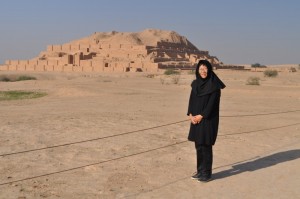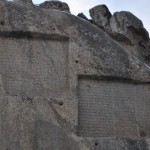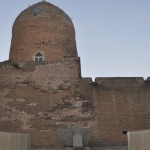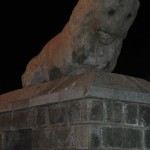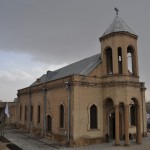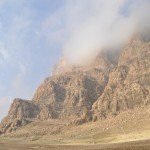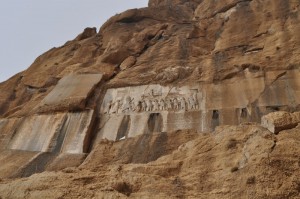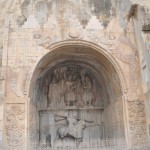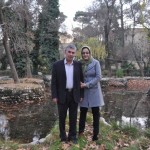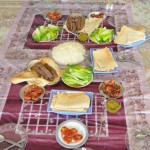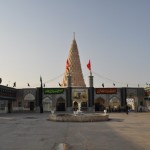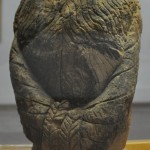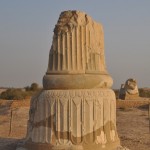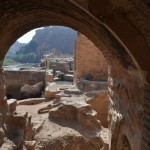Off Beat Track – 6 Days in Western Iran (December 17-22)
Persia has captured travellers’ imagination for centuries. Iran has been on my must – see list for decades. I joined a classic 10-day tour to Central Iran and visited Tehran, Shiraz, Yard, Esfahan, Kashan and Qom (ie the ‘In the footsteps of Empire’ route as described in the Lonely Planet) from December 23, 2010 to January 1, 2011. In addition, I spent another ten days before and after the tour to explore Western Iran.
Iran : Background information
Area: 1,648,195 sq km (world’s 18th largest country) ; Population: over 70 million
GDP : USD 11,200 (2010 est) (Source: The World Fact Book)
History: 13 dynasties from 550 BC to AD 1979, revolution in 1979 and establishment of Islamic Republic of Iran on 1 April 1979
Iran is an elevated plateau with an average height of over 1000 metres above sea level, set between two depressions the Caspian Sea to the north and the Persian Gulf to the south. The central plateau is surrounded by tall chains of mountains ie the Albora Chain, the Zagros Chain and the Markran Chain.
While Central Iran with its gem cities showcases the regions’s greatest civilisations, Western Iran standing at the frontieres with Azerbaijan, Turkey and Iraq, has witnessed many of civilisation’s great empiries. Visitors are advised to read up and to have some knowledge about Iran’s history, arts and culture before arrival. Cities/sites visited during this trip are closely related to the Achaemenids 550-330 BC (1st dynasty); Sassanians AD 224-642 (4th dynasty); Safavids AD 1502-1736 (9th dynasty) and Pahlavis AD 1925-1979 (the last dynasty).
Off the Beaten Track – Western Iran (December 16 -22)
December 16, 2010 (Thursday) – Arrival in Tehran (1100m)
December 17 – Tehran – Hamadan (330km; 5 hrs by bus)
Iran is well-served by efficient and cheap long-distance buses. The 5-hour bus ride to Hamadan (1800m) was comfortable
Hamadan with half a million people, was the classic Ecbatana, the capital of the Median empire around 650BC. It was once one of the ancient world’s greatest cities. I took a taxi to visit a few attractions in the afternoon.
Ganjnameh, 8km outside the city, has two Achaemenian inscriptions carved into the rock face. The first panel was by Darius I (522-486 BC) and the second by his son Xerxes (486-466 BC). The texts were written in three languages (Old Persian, Elamite and neo-Babylonian) thanking the Zoroastrian god Ahura Mazda for making Xerxes a very good king.
The 14th century tomb tower of Esther (wife of Xerxes I) and Mordechai was once Iran’s most important Jewish pilgrimage site. The old tomb keeper kindly opened the 400kg granite door so that I could go inside the tomb tower. There are some Hebrew inscriptions including the Ten Commandments on the walls.
The 2300-year-old Sang-E-Stir, a stone lion, now standing in a park was possibly carved at the behest of Alexander the Great.
December 18 : Hamadan – Kermanshah (about 160km; 3 hrs by minibus)
I spent the morning exploring some Ecbatana excavations and visited a Gregorian Church and a museum on the site. Explanations are inadequate to enable visitors to fully appreciate the archaeological discoveries.
My second stop was the Imam Khomeini Square, the heart of the city. I watched the Ashura festival procession which was colourful and most lively. Ashura, one of the most important religious holidays in Iran, commemorates the anniversary of the martyrdom of the third Imam, Hossein at Karbala (AD 680). During the 10-day celebration, each city has two days of procession with thousands of people chanting ‘Ali’ and self-flagellating! Alamdar is the man carrying an alam which weights 200 to 300kg. Food and fruit are also handed out and I got two apples, some sweets and a sandwich!
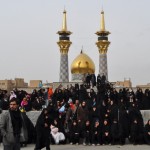 |
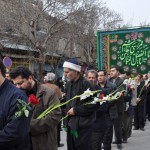 |
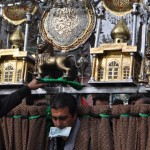 |
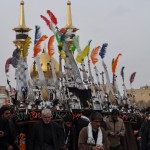 |
In the afternoon, I took a minibus to Kermanshah (1389m) with a population of 800000. It was dark, cold and wet. I took a savaris (shared taxi) with an Iranian family which insisted in giving me a lift. I got off at Azadi Square at the down town area and checked in a local hotel mentioned in the Lonely Planet. The old receptionist could not speak English. Fortunately, an Iranian who can speak some English, came to my rescue and helped me complete the registration procedure. The hotel is shabby and noisy but convenient and cheap.
December 19 : Kermanshah – Bisotun – Kermanshah (60km)
Bisotun (a World Heritage Site) is located along the ancient trade route linking the Iranian high plateau with Mesopotamia (some 30km from Kermanshah) and features remains from the prehistoric times to the Median, Achaemenid, Sassanian and Ilkanid periods. It is famous for a series of historic bas-relief carvings on rocks. The most recognised carving panel is a well-preserved 480 BC Darius receiving supplicants while a winged Zoroastrian ‘angel’ hovering overhead located 70 metres above the ground. The scene is also surrounded by cuneiform (the world’s spiky first alphabet) inscriptions expounding on Darius’s greatness in three lost languages (Elamite, Akkadian and Old Persian).
I explored this vast site, looking at some ruins and an old caravansary under restoration. The scenery, though spoilt by smog, is still impressive. In a savaris back to Kermanshah, I met three young men who were cheerful and talkative. They were keen to find out visitors’ impressions of Iran.
Kermanshah is thought to be founded during the reign of the Sasanian king Bahram IV at the end of the fourth century AD. Taq-e Bostan at the northern edge of the city is famous for a series of bas-reliefs and grottoes carved into the cliff face. These grottoes are unique in Sassanian art. There are two arches with fine carvings. The finest tableau shows the investiture of Ardeshir II (AD 379-383).
December 20 : Kermanshah – Khorramabad (190km; 3 hrs by bus)
While I was awaiting a bus to Khorramabad (1246m), Sara, a 23-year-old Iranian university student introduced herself and offered assistance. She was injured in a car accident and had a cast on her right leg. Her parents (Mohammad and Fearing) came to Kermanshah to bring her home. They invited me to stay with them. After some hesitation, I accepted their invitation and had my first home stay in Iran.
Sara and her sister, Neda both speak English. Though her parents and three younger brothers (aged from 15 to 22) could not speak English, we discussed about education, politics, family and marriage etc with the help of Sara and Neda. Mohammad, who has just retired, prepared kebab for lunch and took Neda and me to see the old town in the late afternoon. The city is not too big with a population of 33,000. Falak-ol-Aflak, a fortress (now a museum) perching at a 40m- high rock in the middle of the bustling old town is the city’s icon of the city. Neda showed me her university which is just below Falak-ol-Aflak. We visited the oldest souk before crossing the city to see an inscribed stone from around AD 1150 which sets out details of local grazing rights.
Fearing treated me with a sumptuous breakfast with three boiled eggs, cream, home made jam, hot milk, bread and tea. Sara’s youngest brother, Amir accompanied me to the bus station to ensure that I took the right bus. The 3-hour ride to Andimeshk is fascinating. The winding highway is well-built going through many tunnels. The scenery is fantastic and photogenic with gorges, desert and rugged mountain ranges. The construction of this road must be an achievement and triumph for the engineers.
When I got off at Andimeshk around midday, I asked a young girl from the bus the way to Shush. She told me in sign language to stay with her as she was heading the same direction. A few minutes later, her father turned up in his car and he gave me a lift! The girl, a university student from Khorramabad, was going home to Choqa Zanbil for holiday. I was indeed lucky and met so many nice people.
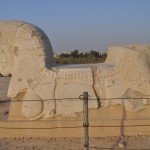 |
Shush, a small town with a population of 100,000, was the site of the city of Susa, capital of the Elamite empire (2000-500 BC), the administrative capital under the Achaemenid king Darius I and one of the greatest cities of ancient Persia. It was probably similar in grandeur to Persepolis when Darius I set it up as his fortified winter capital. It had however disappeared into the sands of time and only re-emerged after British archaeologist WK Loftus surveyed the site in mid 1850s. Today, at the site of Apadana Palace, one can only find some broken columns and bas-reliefs left in-situ with very brief illustrations. From the site and a nearby castle which is closed to visitors, one can see miles of yellow sands and moulds which must have been where Susa once stood. The small Shush museum only has a few pieces of significance on display. The key finds are now in the National Museum in Tehran and Louvre in Paris.
The other place of interest is the Tomb of Daniel, a semi-mystical Jewish figure who was said to have served as an administrator to Darius I (522-486 BC). The tomb was once a Jewish pilgrimage site in Iran.
December 22 : Shush – Choqa Zanbil – Shushtar – Ahvaz (200km; by taxi and savaris)
One of the star attractions of Western Iran is the world’s foremost Elamite sites at Haft Tappeh and Choqa Zanbil (a World Heritage Site). I took a taxi from Shush but the young driver could not speak English. We first stopped at Haft Tappeh, a 3000-year-old site and visited an UNESCO-sponsored museum. Apparently, the museum is too poor to pay for electricity and there’s no power. I could hardly see the display though I had a torch. What a pity!
Choqa Zansil’s magnifcent red brick ziggurat, built some 2500 years ago, is regarded as the best surviving example of Elamite architecture. The ancient inhabitants of proto-Iran attached great importance to mountains. They built pyramidal, tiered temples known as ziggurats where they had no mountain. The town of Dur Untash where Choqa Zansil was built, was founded by King Untash in the mid-13th century BC.
The ziggurat was dedicated to Inshushinak, the chief god of the Elamite pantheon and patron of Shush. It has a square plan with sides measuring 105m. There is a brick-wide strip inscribed in cuneiform. There are also ruins of tombs and 11 small temples dedicated to various Elamite gods and goddesses around the ziggurat. The town was sacked by Ashur-banipal around 640 BC and Choqa Zansil buried in sand was accidentally rediscovered in 1935 during an aerial survey by the Anglo-Iranian Oil Company.
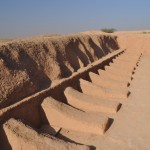 |
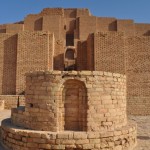 |
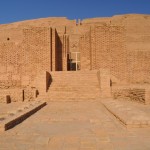 |
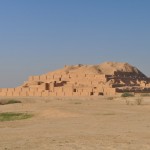 |
The arid landscape from Shush to Shustar is flat but scenic. Shustar’s raison d’etre for millenia was controlling the irrigation of the Khuzestan plains. The land under irrigation and cultivation around Shustar is green and fertile. I saw a set of 700-year old watermills which had provided this arid plain with an efficient and remarkable irrigation system which is now a World Heritag Site.
I had lunch at Hotel Jahangardi by the octagonal Kola Ferangi tower which has good views of the river. After lunch, I took a savaris to Ahvaz in order to catch my flight back to Tehran the following day. The 100-km journey took about two hours. There is not much to do and see in Ahvaz.
December 23 : Ahvaz – Tehran (by air) (End of Part 1)


